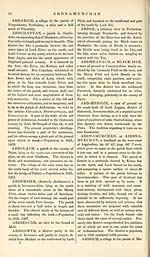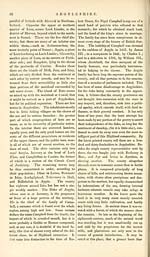Gazetteer of Scotland > Volume 1
(79) Page 51
Download files
Complete book:
Individual page:
Thumbnail gallery: Grid view | List view

ARDROSSAN.
51
thih county of Perth. For antiquities here,
see Muthil.
ARDOCH, a stream running through the
western part of the parish of Dumhlane,
Perthshire, which falls into the Teith at
Doune-castle.
ARDROSSAN, a parish in Ayrshire, bor-
dering on the firth of Clyde, bounded on the
north by Kilbride, on the east by Dairy, and
on the south by Stevenston. The medium
length, from north to south, is about six miles,
and the breadth from three to five miles.
The surface is a mixture of hilly and flat
country.
ARDROSSAN, the capital of the above
parish, is a populous thriving village, of mo-
dern erection, chiefly indebted for its recent
existence to the patriotic exertions of the
Eglintoune family, who had formerly a castle
in the vicinity, of great strength and extent,
but which is now in ruins. A rdrossan posses-
ses the capability of being yet a great sea-port.
It lies 28 miles south-west of Greenock, on a
very accessible point of the coast, and only a
mile west of Saltcoats, which occupies an-
other promontory. Already a pier 900 feet
in length has been constructed at an enor-
mous expense, which will form a spacious and
6ecure harbour fit for the reception of vessels
of every burden, and approachable by every
wind. Some years ago a canal was projected
to be cut betwixt Glasgow and Ardrossan. It
was begun, but, from particular reasons, was
only finished from Glasgow to Johnstone in
Renfrewshire. However, a rail-way was op-
ened between the latter place and Ardrossan
in October 1830, chiefly for the conveyance of
coal for shipment. This line of road opens
up the centre of Ayrshire to the trade of
Glasgow. Ardrossan has become a favourite
resort in the sea-bathing season for the gen-
teel families of Ayrshire and other places,
who can be accommodated with neat and
commodious houses. A large and elegant
hotel, with a suit of warm and cold baths,
was erected by the late Lord Eglinton,
at an expense of not less than L. 10,000.
The same nobleman also fitted up two good
lodging-houses. Fortunately some taste is
displayed in laying out the town on a regular
plan, which is rapidly filling up with good
stone houses. There is an agricultural socie-
ty and different useful associations in the town.
Steam packets ply regularly to and from Glas-
gow, Greenock, Largs, and other places.
There are also regular sailing vessels to Ar-
ran — Population in 1821, 3105.
ARDSTINCHAR. See Stinchar.
ARDTORNISH CASTLE, now in
ruins on the north shores of the sound of
Mull in Argyleshire, in which a treaty be-
twixt the then lord of the isles and Edward
IV. was subscribed.
ARDVARE LOCH, a bay difficult of
entrance, on the west coast of Sutherland-
shire.
ARGYLESHIRE, or ARGYLL-
SHIRE, a large county in the south-western
extremity of the Highlands, partly composed
of a number of peninsulas on the mainland,
and partly of an archipelago of small islands,
scattered along its margin, and in the bosom
of its salt and fresh water lakes, with others
of larger dimensions divided from it by straits
and sounds. The continental part is situated
between 55° 21' and 57° north latitude; is
bounded on the north by Inverness-shire, on
the east by that county, by Perthshire, and
Dumbartonshire, and on the south and west by
different bays and straits of the Atlantic
Ocean. Its extreme length is 115 miles, its
breadth 33, on an average, and it has altogeth-
er not less than 600 miles of coast washed by
the sea. The mainland, including the pen-
insula of Kintyre, has been computed to con-
tain 2735 square miles, while the islands con-
nected with it are supposed to comprise 1063
more, whereby the whole extent of land in
Argyleshire will be 3800 square miles. In
popular phraseology, and on the county maps,
Argyleshire is divided into districts each com-
prehending several parishes. These districts,
or countries, as the natives call them, are de-
fined by mountain ranges or arms of the sea,
which in all cases receive the name of lochs,
that term being applied indiscriminately to
fresh and salt water lakes. In this way there
are five districts in Argyle. First, there is
Cowal, divided from Dumbartonshire by Loch
Long, and bounded by Loch Fine on the
west. Next, betwixt Loch Fine and Loch
Linnhe, and stretching away to the north, is
Lorn, or Argyle proper, as it is termed from
its central compact character. From Lorn
on its south-west quarter, there stretches out
in a southerly direction, like a feeler into the
Irish sea, the peninsula of Cantire or Kintyre,
the extreme point of which is on the same
51
thih county of Perth. For antiquities here,
see Muthil.
ARDOCH, a stream running through the
western part of the parish of Dumhlane,
Perthshire, which falls into the Teith at
Doune-castle.
ARDROSSAN, a parish in Ayrshire, bor-
dering on the firth of Clyde, bounded on the
north by Kilbride, on the east by Dairy, and
on the south by Stevenston. The medium
length, from north to south, is about six miles,
and the breadth from three to five miles.
The surface is a mixture of hilly and flat
country.
ARDROSSAN, the capital of the above
parish, is a populous thriving village, of mo-
dern erection, chiefly indebted for its recent
existence to the patriotic exertions of the
Eglintoune family, who had formerly a castle
in the vicinity, of great strength and extent,
but which is now in ruins. A rdrossan posses-
ses the capability of being yet a great sea-port.
It lies 28 miles south-west of Greenock, on a
very accessible point of the coast, and only a
mile west of Saltcoats, which occupies an-
other promontory. Already a pier 900 feet
in length has been constructed at an enor-
mous expense, which will form a spacious and
6ecure harbour fit for the reception of vessels
of every burden, and approachable by every
wind. Some years ago a canal was projected
to be cut betwixt Glasgow and Ardrossan. It
was begun, but, from particular reasons, was
only finished from Glasgow to Johnstone in
Renfrewshire. However, a rail-way was op-
ened between the latter place and Ardrossan
in October 1830, chiefly for the conveyance of
coal for shipment. This line of road opens
up the centre of Ayrshire to the trade of
Glasgow. Ardrossan has become a favourite
resort in the sea-bathing season for the gen-
teel families of Ayrshire and other places,
who can be accommodated with neat and
commodious houses. A large and elegant
hotel, with a suit of warm and cold baths,
was erected by the late Lord Eglinton,
at an expense of not less than L. 10,000.
The same nobleman also fitted up two good
lodging-houses. Fortunately some taste is
displayed in laying out the town on a regular
plan, which is rapidly filling up with good
stone houses. There is an agricultural socie-
ty and different useful associations in the town.
Steam packets ply regularly to and from Glas-
gow, Greenock, Largs, and other places.
There are also regular sailing vessels to Ar-
ran — Population in 1821, 3105.
ARDSTINCHAR. See Stinchar.
ARDTORNISH CASTLE, now in
ruins on the north shores of the sound of
Mull in Argyleshire, in which a treaty be-
twixt the then lord of the isles and Edward
IV. was subscribed.
ARDVARE LOCH, a bay difficult of
entrance, on the west coast of Sutherland-
shire.
ARGYLESHIRE, or ARGYLL-
SHIRE, a large county in the south-western
extremity of the Highlands, partly composed
of a number of peninsulas on the mainland,
and partly of an archipelago of small islands,
scattered along its margin, and in the bosom
of its salt and fresh water lakes, with others
of larger dimensions divided from it by straits
and sounds. The continental part is situated
between 55° 21' and 57° north latitude; is
bounded on the north by Inverness-shire, on
the east by that county, by Perthshire, and
Dumbartonshire, and on the south and west by
different bays and straits of the Atlantic
Ocean. Its extreme length is 115 miles, its
breadth 33, on an average, and it has altogeth-
er not less than 600 miles of coast washed by
the sea. The mainland, including the pen-
insula of Kintyre, has been computed to con-
tain 2735 square miles, while the islands con-
nected with it are supposed to comprise 1063
more, whereby the whole extent of land in
Argyleshire will be 3800 square miles. In
popular phraseology, and on the county maps,
Argyleshire is divided into districts each com-
prehending several parishes. These districts,
or countries, as the natives call them, are de-
fined by mountain ranges or arms of the sea,
which in all cases receive the name of lochs,
that term being applied indiscriminately to
fresh and salt water lakes. In this way there
are five districts in Argyle. First, there is
Cowal, divided from Dumbartonshire by Loch
Long, and bounded by Loch Fine on the
west. Next, betwixt Loch Fine and Loch
Linnhe, and stretching away to the north, is
Lorn, or Argyle proper, as it is termed from
its central compact character. From Lorn
on its south-west quarter, there stretches out
in a southerly direction, like a feeler into the
Irish sea, the peninsula of Cantire or Kintyre,
the extreme point of which is on the same
Set display mode to: Large image | Transcription
Images and transcriptions on this page, including medium image downloads, may be used under the Creative Commons Attribution 4.0 International Licence unless otherwise stated. ![]()
| Gazetteers of Scotland, 1803-1901 > Gazetteer of Scotland > Volume 1 > (79) Page 51 |
|---|
| Permanent URL | https://digital.nls.uk/97425310 |
|---|
| Description | Volume I: Abbey to Glenartney. |
|---|---|
| Attribution and copyright: |
|
| Description | By Robert Chambers and William Chambers. Glasgow: Blackie & Son, 1838. 2 volumes. |
|---|---|
| Shelfmark | NF.1461.g.7 |
| Additional NLS resources: | |

